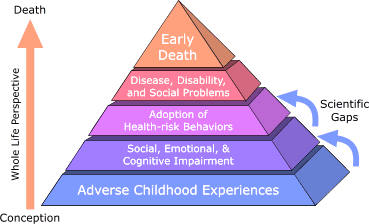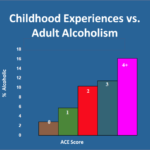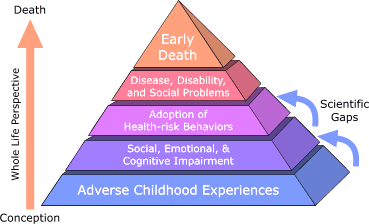Summary/Abstract: The Adverse Childhood Experiences (ACE) Study was a medical study of 17,337 middle-class adults in San Diego. Major results were:
1. Prevalence: 42-67% had two or more ACE childhood traumas such as physical, sexual, or emotional abuse, and emotional or physical neglect. 71% of inner city adults had four or more ACEs. On average 50% suffer child trauma.
2. Morbidity: Child trauma produced in them as adults the top ten non- communicable lethal diseases in the U.S., resulting in early death.
3. Addiction: ACE trauma causes addiction and substance abuse. Conclusion: Healing requires close relationships with compassionate people.
–>Links to summary videos on the ACE Study are given below.
Text:
 The Adverse Childhood Experiences (ACE) Study is a medical study of 17,337 middle-class adult Kaiser Permanente patients in San Diego during 1995-1997. Subjects were asked if they had experienced any of ten categories of “adverse childhood experiences” (childhood trauma) including alcoholism or drug use at home, physical, sexual, or emotional abuse, and emotional or physical neglect (Table 1 under References, below). It was co-directed by Vincent J. Felitti, MD at Kaiser Permanente, with data analysis by Robert F. Anda, MD at Centers for Disease Control (CDC), Atlanta.
The Adverse Childhood Experiences (ACE) Study is a medical study of 17,337 middle-class adult Kaiser Permanente patients in San Diego during 1995-1997. Subjects were asked if they had experienced any of ten categories of “adverse childhood experiences” (childhood trauma) including alcoholism or drug use at home, physical, sexual, or emotional abuse, and emotional or physical neglect (Table 1 under References, below). It was co-directed by Vincent J. Felitti, MD at Kaiser Permanente, with data analysis by Robert F. Anda, MD at Centers for Disease Control (CDC), Atlanta.
Results were shocking. The first major result was prevalence: an incredibly large number suffered childhood trauma. In this middle-class San Diego group, two-thirds or 67% had one or more types of ACEs child trauma, and 42% had two or more types. In 2016, the same survey in inner city Nashville showed that 71% had four or more types. A true national average would show some 50% of Americans suffer childhood trauma.
In the 20 years since 1997, over 400,000 adults worldwide have taken the ACE Study survey, resulting in astonishingly similar statistics.
 The second major result showed that childhood ACE trauma results in lethal disease and early death: The 17,337 San Diego subjects were followed for twenty years since 1997. The ACE Study showed that childhood trauma later produced in them, as adults, the top ten non-communicable causes of death in the U.S. including heart disease, stroke, cancer, lung disease, diabetes, and liver disease. “The odds of having cancer before 50 among women increased twofold for those who had 2+ ACEs versus those with no ACEs,” confirmed a 2012 study of over 6,000 Britons born in 1958, “Childhood adversity as a risk for cancer: findings from the 1958 British birth cohort study,” published by the British Medical Council. The impact of ACEs on adult health was found to be strong, cumulative, and proportionate to the number of types of ACEs. In a large percent of subjects, ACEs resulted in early death (see ACE Pyramid, above).
The second major result showed that childhood ACE trauma results in lethal disease and early death: The 17,337 San Diego subjects were followed for twenty years since 1997. The ACE Study showed that childhood trauma later produced in them, as adults, the top ten non-communicable causes of death in the U.S. including heart disease, stroke, cancer, lung disease, diabetes, and liver disease. “The odds of having cancer before 50 among women increased twofold for those who had 2+ ACEs versus those with no ACEs,” confirmed a 2012 study of over 6,000 Britons born in 1958, “Childhood adversity as a risk for cancer: findings from the 1958 British birth cohort study,” published by the British Medical Council. The impact of ACEs on adult health was found to be strong, cumulative, and proportionate to the number of types of ACEs. In a large percent of subjects, ACEs resulted in early death (see ACE Pyramid, above).
 The third major result showed childhood ACE trauma is a major cause of addiction and substance abuse. The ACE Study showed that addiction is an attempt to gain relief from the anxiety and emotional pain produced by early life traumas, and the need to hide those traumas deep inside — by using psychoactive materials that numb anxiety and pain. It found that the compulsive use of alcohol, nicotine, and injected street drugs increases proportionally in a strong, graded, dose-response manner that closely parallels the intensity of adverse life experiences in childhood:
The third major result showed childhood ACE trauma is a major cause of addiction and substance abuse. The ACE Study showed that addiction is an attempt to gain relief from the anxiety and emotional pain produced by early life traumas, and the need to hide those traumas deep inside — by using psychoactive materials that numb anxiety and pain. It found that the compulsive use of alcohol, nicotine, and injected street drugs increases proportionally in a strong, graded, dose-response manner that closely parallels the intensity of adverse life experiences in childhood:
–18% of the ACE Study population with 6+ ACEs habitually smoke tobacco
–16% of the ACE Study population with 4+ ACEs are alcoholics
–14% of the ACE Study population with 6+ ACEs have injected street drugs
“With an ACE Score of zero, you have a very medically un-interesting population: non-obese, non-smoking, non-alcoholic, non-diabetic, non-hypertensive… But with an ACE Score of four or more, this is big medicine! The combination of their high prevalence, and their great power, makes ACEs the leading determinant of what happens to the health and social well-being of a nation’s population.” – Dr. Vincent Felitti, MD, ACE Study Co-Director
Healing ACE Childhood Trauma
Healing ACE childhood trauma has been shown to be effectively accomplished by “mammalian attachment,” the formation of close personal relationships:
1. The first step is education and exposure. Traumatized students taught about the ACE Study realize that they are not “weird,” crazy, or alone and so become able to share their experiences and their pain with the group. The film “Paper Tigers” has shown students being helped by doing a live ACE Study survey in the classroom using their smart phones, showing the whole group’s combined ACEs trauma score on a screen in front of the room.
2. The second step is encouraging sufferers to form close relationships with compassionate adults willing to hear their stories. In “Paper Tigers,” school officials stop asking “What’s wrong with you?” and suspending students; instead they ask “What happened to you?” and start listening. Suspensions fell 90%, expulsions fell 30%, and attendance, GPAs, exam scores and graduations rose. Kids went to college. The second ACE Study film, “Resilience,” goes further into the ACE Study and exposing the prevalence and lethal nature of ACE child trauma, and the possibilities and methods of healing.
Videos
1. ACE Study 13-minute summary by Dr. Vincent Felitti: https://www.youtube.com/watch?v=GQwJCWPG478
Full speech, Felitti, VJ MD. “The Relationship of Adverse Childhood Experiences to Adult Health Status,” speech at the Child Trauma Treatment Network Conference, September 2003, Snowbird, Utah, National Child Traumatic Stress Network (NCTSN, www.nctsn.org) https://www.youtube.com/watch?v=Me07G3Erbw8
2. CDC’s 3-minute summary of the ACE Study: https://vimeo.com/41156294
References
—————————————-
Table 1. Categories of Adverse Childhood Experiences and percent of ACE Study participants who suffered each trauma:
Household Dysfunction, by Category
1 Alcoholism or drug use in home – 27%
2 Divorce or loss of biological parent while under 18 – 23%
3 Depression or mental illness in home -17%
4 Mother treated violently -13%
5 Imprisoned household member – 5%
Personal Abuse by Category
6 Physical abuse (by parents) – 28%
7 Sexual abuse (by anyone) – 22%
8 Psychological (emotional) abuse (by parents) – 11%
Personal Neglect, by Category
9 Emotional neglect (by parents) – 15%
10 Physical neglect (by parents) – 10%
———————————————–
1. Felitti VJ MD, Anda R MD, et al. Relationship of Childhood Abuse and Household Dysfunction to Many of the Leading Causes of Death in Adults: The Adverse Childhood Experiences (ACE) Study. Amer Journal of Preventative Med, May 1998, Vol 14, Issue 4, p245-258 http://www.ajpmonline.org/article/S0749-3797(98)00017-8/pdf
2. Felitti, VJ MD. The Relationship of Adverse Childhood Experiences to Adult Health Status, speech at the Child Trauma Treatment Network Conference, September 2003, Snowbird, Utah, National Child Traumatic Stress Network (NCTSN, www.nctsn.org) https://www.youtube.com/watch?v=Me07G3Erbw8
Thirteen-minute key excerpts https://www.youtube.com/watch?v=GQwJCWPG478
3. CDC ACE Study website http://www.cdc.gov/violenceprevention/acestudy/about.html
4. Felitti VJ MD, Anda R MD. The Relationship of Adverse Childhood Experiences to Adult Medical Disease, Psychiatric Disorders and Sexual Behavior: Implications for Healthcare. In: Lanius R, Vermetten, E. The Hidden Epidemic: Impact of Early Life Trauma on Health and Disease. Cambridge, MA: Cambridge University Press; 2010. p77-87. http://www.unnaturalcauses.org/assets/uploads/file/ACE%20Study-Lanius.pdf
5. Felitti VJ MD, Anda R MD. The Lifelong Effects of Adverse Childhood Experiences. In: Chadwick J. Child Maltreatment, Sexual Abuse and Psychological Maltreatment, Vol 2. St. Louis, MO: STM Learning; 2014. p 203-215. http://www.ajpmonline.org/article/S0749-3797%2898%2900017-8/fulltext#back-BIB65
6. Karr-Morse R, Wiley M. Scared Sick. New York, NY: Penguin Basic Books, 2012; p.xiv
![]()


